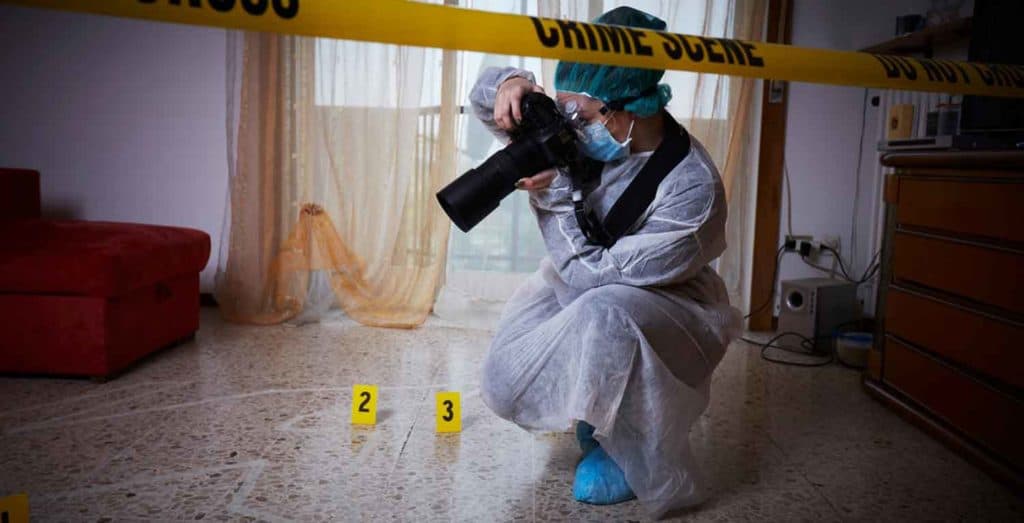
What is photographic evidence?
Photographic evidence consists of the images captured by an investigator or forensic photographer at a crime scene that indicate critical information about the crime. A crime scene photographer has the responsibility to preserve a scene and document evidence exactly as it was originally found, with no room for interpretation. Each photo must be true and accurate, with the ultimate goal of admissibility in the courtroom, should the case go to trial.
Admissibility in court for photographic evidence is determined by each photo’s relevancy, accuracy, authenticity and originality.
- Relevancy: The photo must have a clear purpose for being presented in court. If the photo does not help to demonstrate whether a crime did or did not occur, there is no reason to introduce it into the courtroom.
- Accuracy: Does this photo represent what was observed by the naked eye at the scene? Witness & investigator views should align with what was captured in the photograph.
- Authenticity: The photo must be verified for accuracy by a qualified individual, such as a forensic photographer. This individual must be willing and prepared to testify.
- Originality: The photo must be presented in its original form, whether that be the film negative or a digital .jpg. It should not be edited, formatted or modified in any way.
When we hear the question, “What is photographic evidence?” we can also talk about several types of photographs. At a crime scene, photographers initially capture overall images to illustrate the location and boundaries of the scene, while mid-range images capture spatial relationships and precise positions of evidence. Lastly, close-up images fill up the entire camera frame with the identifying features of each item of evidence. These close-up images will include a scale to show the size and specific details of a piece of evidence. Overall photographs can be quickly captured with OSCR360, whereas mid-range and close-up photographs are best captured with a standard DSLR camera. For more, view our blog “What Types of Photographs are Taken at Crime Scenes.”
What is digital evidence?
While photographic evidence is one type of digital evidence, its important to note that digital evidence isn’t necessarily just photographic evidence. What is digital evidence? Well, digital evidence can include any electronic media file that is pertinent to a case. Once again, evidence must be relevant, accurate, authenticated, and original for courtroom admissibility. Examples of digital evidence may include:

- Video – Including surveillance & body cam footage.
- Audio – Including sound clips/recordings.
- Text files or documents – Including emails/texts, PDFs, word documents, etc.
- Computer files.
OSCR360 uses photographic evidence, captured in 360-degrees by OSCR’s spherical camera, to serve as a container for the additional digital evidence from a case. Here’s how it works:
- OSCR360 is first used at the crime scene to capture overall photographs of each room/outdoor space involved in the crime. Save each image in .jpg format for courtroom admissibility. OSCR automatically time-stamps all photos and includes GPS coordinates to show photo originality and authenticity.
- Using the OSCR360 desktop software, organize and integrate your other digital evidence by using ‘points of interest’ within the spherical photo. For instance, associate a close-up photo of a piece of evidence to that same piece of evidence seen in the spherical photo.
- After all additional evidence has been added to your OSCR case project, use OSCR to present the case in court and gain case closure with convictions. OSCR has been used in court, in grand jury, closing arguments and in obtaining pleas with presentations to the defense. Using one single platform creates a seamless, easy-to-follow courtroom presentation that provides viewers with a virtual walkthrough of the crime scene.
“OSCR360 eliminates the need for anyone other than critical personnel to enter a crime scene, keeping it in pristine condition without people trampling your evidence. You bring the scene to them – imagine showing the scene to command, investigators, district attorneys, and lab personnel, in its entirety, without them being there. Imagine placing witnesses and victims back in the middle of the scene to help them remember details. With OSCR360, everyone views the scenes in a whole new way.”
Hank Kula, Ret. Sergeant, L-Tron Law Enforcement Support
More on Digital Admissibility
As we’ve discussed, relevancy, accuracy, authentication, and originality of digital evidence are the keys to courtroom admissibility. But, how can you prove that digital photos and other media haven’t been altered?
Establish an agency-wide policy of Standard Operating Procedures (SOP) to follow for every case. Consider the following as you are developing your procedures:
- Preserve electronic evidence in its original form (many agencies use a hard drive or CD).
- Track and document each piece of evidence (answer the “who,” “what,” “when,” “where,” “why,” and “how” questions).
- Prevent purposeful and accidental alterations (save the files as “read-only” and restrict file access to essential personnel).
- Create a new file for analyzation purposes and leave the original file as is (re-name the new file to avoid confusion).
- Maintain chain-of-custody from the moment of evidence collection through case closure.
Interested in seeing how OSCR has been used in court? View the the Rideout Trial use case:
Interested in more information on forensic photography? Download our “Guide to Forensic Photography:”